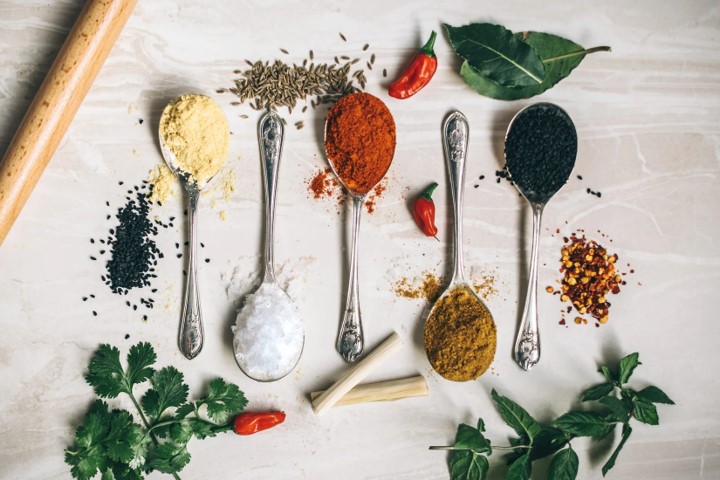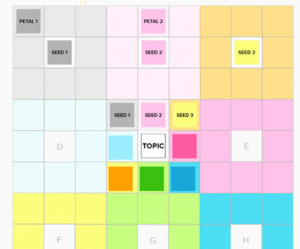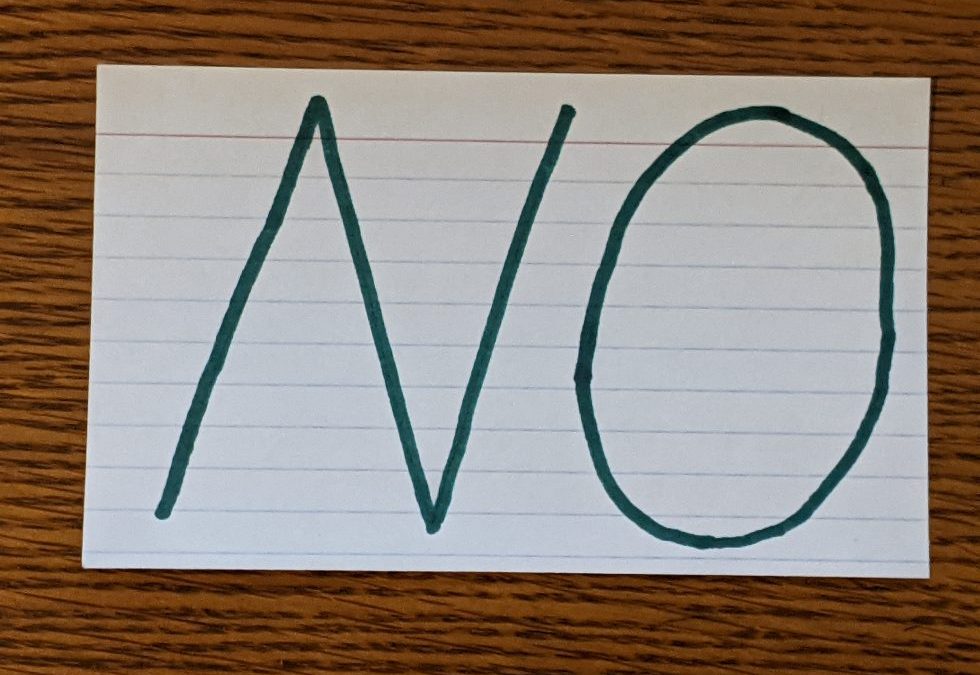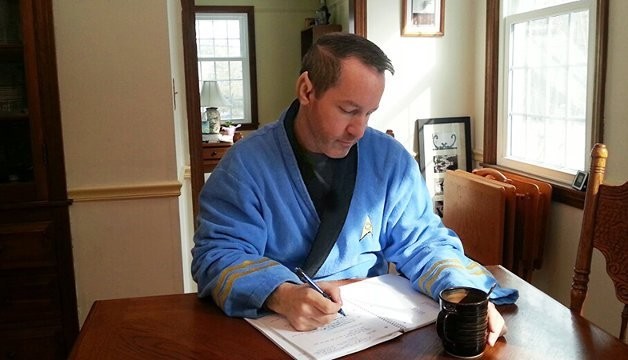
by dbward | Mar 15, 2021 | Facilitation Tips, Tools 101
If you’ve ever watched an instructional cooking show, you have probably seen the chef or host say something along the lines of “Now we add two tablespoons of cinnamon…” as they reach for a small conveniently placed bowl that contains just the right amount of the necessary ingredient.
What you don’t see is the production assistant hunting through cupboards and measuring out all the ingredients before the camera starts rolling. The prep work is the essential step that makes those shows watchable and makes the recipes look a lot easier and faster than they are in my kitchen.
Those little bowls of pre-measured ingredients are part of a culinary technique called mise en place, which is French for “everything in its place.” It turns out, mise en place does more than make cooking shows easier to watch. It can also make your ITK session more effective.

A seeded Lotus Blossom
For example, when I’m preparing to lead a Lotus Blossom session, I might fill in a few of the boxes to get things started, like in the accompanying image. Think of it as a seeded lotus blossom. This helps accelerate the discussion in several ways. First, it demonstrates how to use the tool by providing some examples of the types of things participants might put in the various petals.
It also begins to plant some ideas and gives the group a starting point. I don’t fill in much – usually just two or three petals, enough to convey the basic practice and to help get the conversation started.
And of course, if any of the seed ideas are worth keeping, then we’ve already got some materials before the session formally starts.
Similarly, when I lead a Premortem, I like to do a little pre-Premortem. I’ll go through the canvas and answer some of the questions a few days before the event begins, maybe with the organizer of the event. If the group organizer has not done a premortem before, this gives me a chance to explain it to them in advance. They also get to put some of their ideas together in advance of the session, which can help the whole group hit the ground running.
So give it a try. The next time you’re going to use one of the ITK tools, do a little prep work and measure out a few of your ingredients. I think you’ll find it helps make the whole experience move along smoothly.
photo credit: Calum Lewis on Unsplash

by dbward | Mar 1, 2021 | Innovation Coaching
So your recent session was a bust. You tried to do something but it crashed and burned. Let me be the first to say “Congratulations, and welcome to the club!”
This situation is pretty much inevitable. Stick around in the innovation space long enough, and eventually something going to go pearshaped. And by “long enough,” I mean a day or two. Or less.
See, when the work you’re doing involves introducing novelty that has impact, some of that novelty is pretty much guaranteed to not have the impact you anticipated. It might even impact you right in the face.
For the Innovation Toolkit in particular, every facilitator has led a session or used a tool where the result ended up in the Crummy column instead of the Awesome column. It’s sort of a rite of passage around here. We’ve all had our flops and flubs and disasters, where the participants didn’t participate, the tool didn’t fit, the metaphorical souffle didn’t rise. It happens to the best of us.
Like I said, welcome to the club.
But I also said congratulations, and that’s important. In order to have a failed attempt, you must first make an attempt. So if you failed, that means at the very least you tried something… and that’s worth celebrating. In fact, it probably means you tried something new, which is very celebration-worthy in my book. We need people who are willing to try new stuff – stuff that might not work – and so we celebrate those who take the leap.
Then again, maybe your latest failure is because you got lazy and phoned it in. Maybe your failure was entirely your own fault. That may sound like a dubious thing to celebrate, and it’s frankly my eleventh-least favorite type of failure, but upon closer inspection we may discover something to celebrate there too.
Maybe the reason you didn’t put in the effort is because you’ve put in so much previous effort, you’ve had so much previous success, that you got a little complacent. Resting on your laurels may not be admirable, but it does mean that at some point you earned some laurels. So that’s cool. And let me tell you, those post-success-failures can be a really helpful wake-up call… and that’s why I say congrat’s on noticing the problem and waking up. You are now more aware of what you need to do than you were before. Congratulations.
The other thing to keep in mind is that virtually no failure is completely worthless. You probably created some value, even if it’s not as much value as you’d hoped to create. You probably learned something, even if it wasn’t what you wanted to learn. And there’s a really good chance you helped someone, even if it’s not quite in the way you wanted to help.
At the very least, you survived, so that’s something. Congratulations… and welcome to the club.
(Image credit: Quino Al from Unsplash)

by dbward | Feb 15, 2021 | Innovation Coaching |
It’s only two letters, but “no” can be a hard word to say.
There are lots of reasons it’s hard to say no, particularly for members of Team Toolkit. We’re an enthusiastic, positive, and curious bunch. We love trying new things and are committed to building a culture of generosity. We love helping people, we sincerely enjoy the work, and we explicitly bring a “Yes, And…” mentality to all our activities. So when a new request comes in, when someone reaches out and asks for our time and attention, our natural inclination is to say yes.
But sometimes, yes is the wrong answer. Sometimes we need to say no. And that’s hard.
Difficult or not, it’s super important to turn down some requests. A discipline of saying no helps us stay focused on the most important, impactful work, and do it in a sustainable way. It prevents us from getting burned out, overcommitted, or spread too thin, from doing work that is not a good fit, or from being distracted from our actual mission. But even though it’s good and important to turn down some opportunities, it’s still not easy to do.
Why is it so challenging? Well, sometimes we feel guilty about saying no, like we’re letting people down by not accepting the invitation. Other times we feel scared, because we’re not sure how the other person will respond or how the decision might impact our career. Saying no can feel like a contradiction to our fundamentally positive character. And of course there’s also FOMO – the fear of missing out, particularly when the thing we’re saying no to sounds like it would be a positive opportunity. It’s tough to say no when a big part of you wants to say yes.
Here are a few techniques that help me in this area:
Do it quickly. Don’t leave the other person hanging for too long – that’s not nice to them, and the longer we delay, the more pressure we feel to say yes. Plus, delaying a decision just eats up the time we’re trying to protect by saying no in the first place.
Set boundaries in advance. Create a little rubric to help filter incoming requests. Just as a plumber should turn down a customer’s request to do electrical work, we decline invitations that don’t require our tools and specialties. For example, if someone asks us to simply run a meeting, we say no. That’s not the kind of facilitation we do.
Don’t offer an explanation. “No” is a complete sentence, and it is perfectly legitimate to say, “Sorry, I can’t do that.” Other variations might include “I’m not available” or “That’s not a good fit.” Resist the urge to give a detailed explanation of why you can’t do it, why it’s not a good fit, or what higher-priority activities you’re already committed to. You’re making a decision, not starting a debate.
Do offer an alternative. Depending on the nature of the request we’re declining, we may be able to suggest a different option. Something like “I’m not available tomorrow but I’m free next Thursday.” Or “I’m not available but maybe Rachel is.” Of course, you can still say no even if you don’t have an alternative, but it helps both parties if you can offer a Plan B.
Don’t negotiate with yourself. Avoid saying stuff like “I can’t do it tomorrow unless you really need it ok maybe I can, just hold on while I rearrange my calendar…” Before you turn your no into a yes, give the other person a chance to accept the first answer. And if they do come back and ask again, you can still hold on to your first “no.” You knew what you were doing when you said it the first time.
One final observation: Saying no takes practice. Just like all hard things, we get better at it the more we do it. So you’re invited start with just one “no” this week and see what happens. We’d love to hear how it goes!

by dbward | Feb 1, 2021 | Misc Awesomeness
Can I tell you a secret? For every post I publish here, there’s at least half a dozen you’ll never see.
I’m not just talking false starts, where I have a stub of an idea that ends up not going anywhere. I’m talking about whole posts on topics that don’t quite land, don’t cohere, don’t resolve into anything worth sharing. Even though I am a pretty experience writer, the truth is I write a TON of worthless stuff that (appropriately!) never sees the light of day.
And it’s not just crummy first drafts. I actually spend a fair amount of time editing, revising, and reworking material, in the hopes of creating something useful… before quietly setting it aside and starting over with a blank page.
The thing is, I can never tell whether a post is going to be worth sharing until I write it. An idea might look promising at the start, but only reveal its true value (or lack thereof) once it’s gone through a few versions. For that matter, the idea itself might not be terrible, but my ability to express the idea comes up short. That probably means I don’t really understand the idea very well. Or maybe it means I need to more sleep, more coffee, or less screen time.
The funny thing is, this willingness to create bad work and then dispose of it seems to be the secret to doing things well. Not just in terms of blog posts, but all sorts of other endeavors. When I give myself permission to create badly – and permission to toss away the results of that work – I find myself in a more creative and productive mindscape. I am free to play, to noodle around, to explore and experiment, because the pressure is off. If the thing I’ve created isn’t very good, nobody ever has to know. I can just delete it and try again.
And yes, 6 times out of 7 the result is… pretty bad. Which is precisely as expected, and that’s ok. But every once in a while a flower grows in that pile of manure. Not in spite of the bad drafts – because of them. I’m sharing this story as an invitation to give yourself permission to play, to make bad art, to delete your disposable drafts… and to keep going. You may also want to get a Star Trek bathrobe, but that’s not required.
by dbward | Jan 5, 2021 | Uncategorized

Today’s post is by guest blogger Riley Fujioka!
Did you know that 2.2 billion people lack access to safely managed drinking water? Or that globally, 1 in 4 healthcare facilities lack basic water services? You can help bring clean water to these underserved communities.
At MITRE, we have to come together to put a dent in these statistics by partnering with Wine to Water, an international non-profit organization focused on ending the root cause of global poverty. They provide sustainable water solutions in communities around the world, and we’re working with a student-led team at The Madeira School on a volunteer event. Our goal is to reach over 1,000 people with clean water by raising money to build clean water filters and to make a difference through the power of clean water.
Between now and late January, we invite you to join our fundraiser. Your donation will enable Wine to Water to obtain and distribute filter building kits that will be sent to all fundraiser contributors. Then, during our virtual filter building event on World Water Day, March 22, you can build the filters at home. These will be distributed globally to communities in need and also support disaster relief efforts.
Leading up to this event in March, we will host a series of keynote speakers from the Wine to Water team as well as members of communities around the world who will be directly impacted by these filters, so you can learn more about the positive impact you will be making through this effort. We’ll be sharing registration details as the virtual events are scheduled.
According to Shared Justice: ‘Unclean water can cause serious and costly health issues, and studies have found that poor and minority communities across the U.S. are disproportionately affected by polluted waters.’ The issue is much worse outside of the United States, where lack of sanitation and access to basic health care led to millions of deaths each year.”
Each filter costs around $50 in materials to make and distribute. To participate in a virtual hands-on experience to build kits for families around the globe without clean drinking water, contribute to our fundraiser, and register for the event here.
Please join us in fundraising and building clean water filters for communities all around the world!
©2021 The MITRE Corporation. All rights reserved. Approved for Public Release; Distribution Unlimited. Case Number 20-3448






